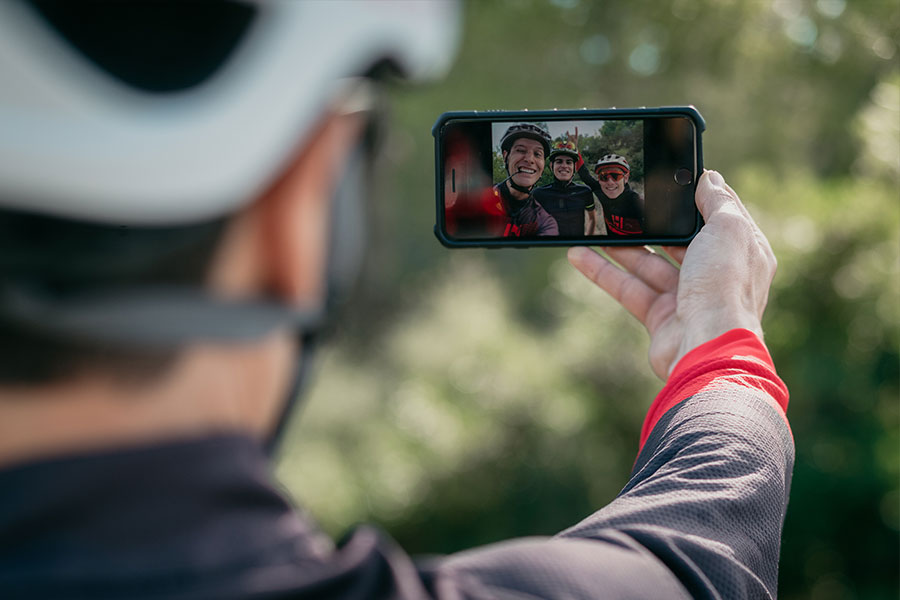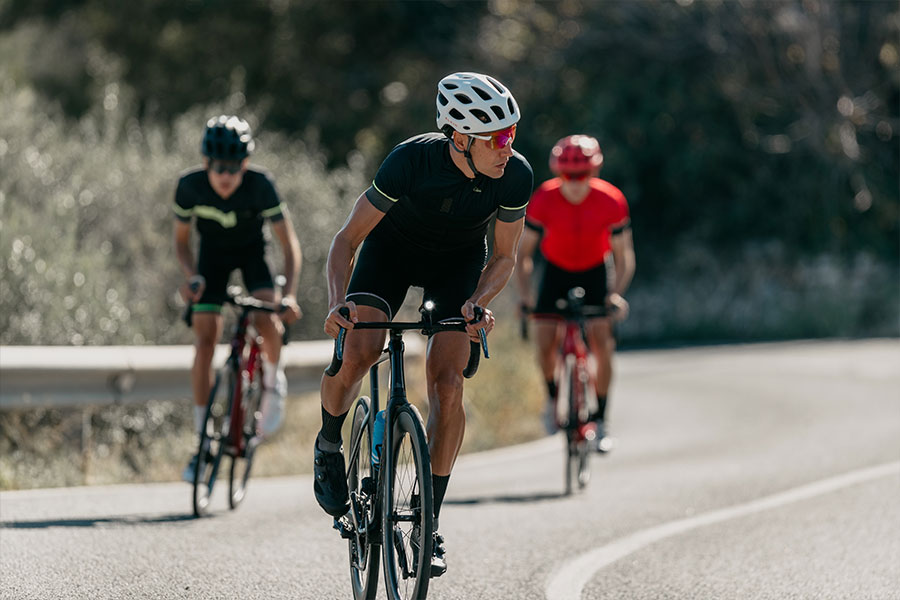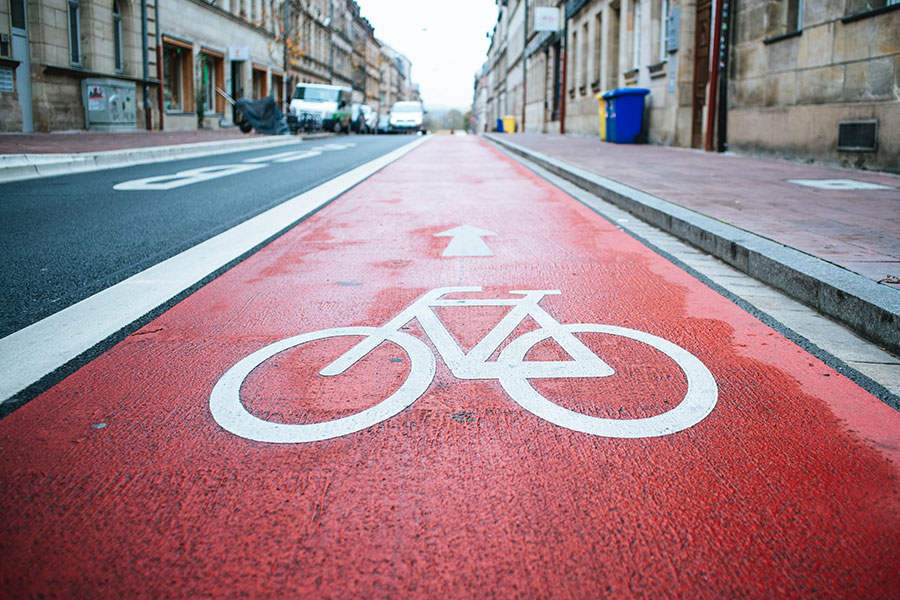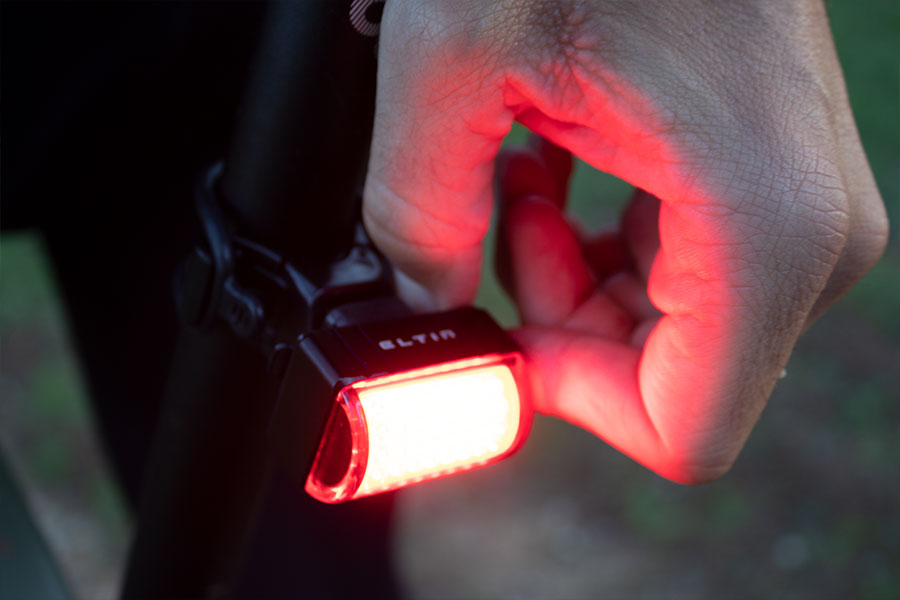Here's the English translation of your paragraph:In this article, we want to help you get to know the cycling regulations and the updates for 2025. Knowing and respecting the rules is essential to ride safely and maintain harmony among all vehicles and pedestrians on the road. Join us and discover the most important ones!
Cycling Regulations and Updates for 2025
New DGT regulations in 2025 to increase cyclist safety:
In urban areas, the priority is clear: cyclists must ride in the center of the lane, and vehicles are required to keep a minimum distance of 5 meters behind them. This measure aims to provide greater visibility and protection for those traveling by bicycle.
On roads, overtaking precautions are being reinforced. Now, any driver wishing to overtake a cyclist must do so at a speed no more than 20 km/h below the speed limit for that section, while always maintaining a minimum lateral distance of 1.5 meters. A double safeguard to prevent dangerous maneuvers.
At night or in low-visibility conditions, active visibility comes into play: the use of certified reflective elements is mandatory, and they must be visible from at least 150 meters away. A key measure to reduce risks in adverse conditions.
When you're riding a bike, the first thing you need to consider is doing so under safe conditions. As we share the road with other vehicles and pedestrians, we must all be respectful and follow a set of rules to avoid accidents.
As a cyclist, there are many actions you should take to increase your safety. We’ve covered many of them in previous blog articles: properly tuning up your bike; wearing a helmet that offers effective protection; choosing the right clothing for each situation and specific to cycling; selecting the most suitable cycling glasses; performing proper maintenance; and having a good lighting system that allows you to see and be seen.
Alongside all these recommendations is the DGT regulations. While a special license isn't required to ride a bicycle—as it is with motor vehicles—there are still a number of rules every cyclist must know and follow. Some regulations depend on the type of road, but most are general. Let’s take a look at them.
Can I Use My Mobile Phone While Cycling?
While riding a bicycle, you are not allowed to use your mobile phone in any way. That means no holding it to your ear during a call, no using it in your hand to reply to a message, or to take a photo, for example. If you want to use it, you must stop cycling.
In addition, headphones and hands-free devices are also prohibited. They limit your hearing and significantly reduce your ability to react in case of an unexpected situation.
The fine for using a mobile phone or headphones can be up to 200 euros.

No Alcohol When Riding a Bicycle
Although it may seem obvious, it's worth remembering that operating any type of vehicle after consuming alcohol must be avoided under all circumstances and is strictly prohibited.
The maximum permitted alcohol levels are the same as for drivers in general (0.5 g/l of alcohol in blood or 0.25 mg/l in exhaled air). If an officer stops you for a test, you are required to comply. For minors, any positive alcohol level is prohibited — it must always be 0.0.
Riding under the influence of alcohol is so dangerous that the fine ranges from 500 to 1,000 euros depending on the level and whether it's a repeat offense, and the bicycle will be immobilized.
How Should Cars Overtake Cyclists?
Unfortunately, one of the main dangers for us cyclists continues to be the moment when motor vehicles try to overtake us. In fact, improper overtaking is one of the leading causes of serious or fatal accidents. For this reason, the DGT has strengthened the rules in 2025 to protect us even more.
Now, in addition to respecting the mandatory one and a half meters of lateral distance, drivers must reduce their speed by at least 20 km/h below the speed limit when overtaking on interurban roads.
Moreover, on roads with more than one lane per direction, changing lanes completely is no longer a recommendation but a legal obligation. If the driver fails to change lanes when overtaking you or does not respect the minimum distance, they will be penalized with 6 license points and a fine.
The bicycle remains the most vulnerable vehicle on the road, and these measures aim to ensure that every overtaking maneuver is done with safety, calm, and respect.
Should I Always Use Lights on My Bicycle?
Yes, it is mandatory to use lights on your bicycle between sunset and sunrise, when riding through tunnels, underpasses, or when weather conditions reduce visibility (fog, heavy rain, etc.).
The DGT establishes that in low visibility situations, the cyclist must be visible from at least 150 meters away. This may require the additional use of reflective accessories or higher-intensity lights.
Furthermore, all bicycle lights must be approved by the European Union, as using non-certified devices can also lead to penalties.
The mandatory lighting system includes:
- White front light
- Red rear light
- Non-triangular red rear reflector
- Optionally: yellow reflectors on the spokes and pedals
The fine for not having the proper lighting, or for using non-approved lights, can be up to 200 euros.
Extra recommendation: Even during the day, keeping your lights on improves your visibility and reduces the risk of accidents. A rear red light, for example, helps vehicles detect you sooner and maintain the correct safety distance.
You can find a wide selection of approved lights in the Eltin catalog.
Is Wearing a Helmet Mandatory When Riding a Bicycle?
Yes, wearing a helmet is mandatory for all cyclists, both on interurban roads and in urban areas, and on any type of terrain. Starting in 2025, the regulation states that helmets are mandatory for all cyclists without exceptions, regardless of the situation (neither long climbs nor extreme heat exempt its use).
For those under 16 years old, wearing a helmet is mandatory on any type of road.
The helmet must be approved by the European Union to ensure maximum protection. The fine for not wearing a helmet can reach 200 euros, and authorities have the power to enforce this rule.
Although there are no longer exceptions, our advice remains to always wear a helmet, regardless of the regulations. It is a fundamental protective measure that can prevent serious injuries and even save your life in case of an accident.
The Use of Reflective Gear on Bicycles
Wearing a reflective garment is mandatory when riding a bicycle in low visibility conditions or when lights are in use. This applies to both interurban and urban roads. Starting in 2025, regulations require cyclists to be visible from a distance of 150 meters.
Fines: If you do not wear a reflective garment, the fine can be up to 100 euros, and in some cases, other accessories that do not meet visibility standards may also be penalized.
Our recommendation is that even though the regulation only requires it in certain situations, we suggest always wearing bright-colored clothing or with reflective details to increase your visibility, even during the day. Additionally, additional reflectors on spokes and pedals are an excellent option to be more visible and improve your safety.
When Should I Ride on the Shoulder?
On the road, you must ride on the right shoulder whenever it exists and is in good condition. You may only leave it during long descents if you can do so safely.
If you do not ride on the shoulder when it is available, you can be fined up to 200 euros.
Is Riding a Bicycle in a Group Allowed?
When you ride with someone or in a peloton, you can ride two abreast as far to the right side of the road as possible, with one of you on the shoulder (if there is one). Drivers of other vehicles are always required to leave one and a half meters of safety distance when overtaking you.
However, when riding in areas with low visibility such as curves, or when congestion forms due to narrow roads that prevent overtaking, you must line up single file to increase safety.
At roundabout entries and priority zones, a peloton is considered a single unit, meaning you must yield from when the first passes until the last does.
Therefore, riding in a group must be done in an orderly manner, following regulations and adapting to each situation. Riding on the road in a group without any order not only puts you and your companions at risk but also entails a 100 euro fine for each cyclist.

No Riding Bicycles on Sidewalks and Pedestrian Crossings
It is prohibited to ride a bicycle on sidewalks and pedestrian areas, unless they are marked as shared zones for pedestrians and cyclists, or as bike lanes. If you want to use the sidewalk, you must get off the bicycle and walk it. Failing to comply with this rule may result in a fine of 100 euros.
The same applies to pedestrian crossings, which are exclusively for pedestrians, as their name indicates. To cross them, you must get off the bicycle if you want to avoid a fine that can reach 200 euros.
Fortunately, awareness about the importance of using bicycles as a means of transport and sustainable mobility is increasing, so cities are investing in remodeling streets, especially main ones, with bike lanes and cyclist crossings that allow safe travel without having to share the road with motor vehicles, with the dangers that entails. Whenever possible, it is recommended to ride on these lanes.
Respect Traffic Signs, Even as a Cyclist
Traffic signs apply to all road users, including cyclists. You must obey traffic lights, vertical signs (stop, yield, speed limits, school zones...), and pedestrian crossings. The fine for running a red light or failing to respect a sign or pedestrian crossing ranges from 150 to 200 euros.
Unfortunately, many cyclists believe that approaching the intersection slowly and checking for oncoming traffic is enough, but this is a mistake. You must wait for the traffic light to turn green and stop properly where required, whether at yield signs or stop signs, before continuing. A similar issue occurs at pedestrian crossings, where cyclists often fail to yield to pedestrians or weave through them while crossing. This is incorrect and dangerous behavior that should be avoided; the proper action is to stop until pedestrians have safely crossed.

Signal the start of your ride and your maneuvers on your bicycle
When you join traffic, turn, or change direction or lane, you must signal it. Before starting to move, you should check that you can do so safely without nearby vehicles having to brake suddenly. Signals should be made with your arms, extended or bent at an angle depending on whether you want to turn right or left, or indicate merging onto the road… Similarly, you can warn of a sudden stop by moving your arm up and down in short, quick movements. This signaling is not mandatory because it requires letting go of the handlebars and should only be done if it does not compromise your balance, but it is recommended whenever possible.
If you fail to do this and join traffic dangerously or ride without signaling maneuvers, the fine can be up to 200 euros.
Right of way for cyclists
As a cyclist, you have the right of way over motor vehicles when riding on bike lanes, cyclist crossings, or a marked shoulder. For example, if you are riding on the shoulder and a vehicle wants to turn right because there is an entrance, and this involves crossing the shoulder, the vehicle must wait for you to pass before making the maneuver.
Additionally, penalties have been increased for drivers who park or stop their cars invading part of a cyclist crossing or bike lane. This is completely prohibited.
In all other situations and intersections, you must obey the rules and signs if you want to avoid a fine of up to 200 euros, as previously mentioned.

Until what age can I carry a child on my bicycle?
If you are thinking about carrying your child or a minor on a bicycle, you should know that this is possible if you comply with three rules: the seat must be certified, the child cannot be older than 7 years, and you as the rider must be of legal age.
The fine for improperly carrying a child or transporting a person over 7 years old on your bicycle can reach 100 euros.
Is a bell on a bicycle mandatory?
Aunque quizá, como le pasa a mucha gente, desconocías esta norma, es cierta y puede acarrear multas de hasta 80 euros. Es obligatorio llevar timbre en tu bicicleta y utilizarlo para advertir de algún peligro. Están prohibidos otros elementos acústicos como campanas o bocinas.
Bicycles in the city: should they ride on the right or in the center of the lane?
Until now, when riding a bicycle in the city and there is no designated bike lane, you must ride as close as possible to the right side of the lane, leaving a safe distance from the curb or parked cars.
However, with the new recommendations from the DGT, this changes and you can ride your bicycle in the center of the lane like any other vehicle.
Can I ride my bicycle in the opposite direction?
Yes, on one-way streets with a speed limit of 30 km/h, bicycles are allowed to ride in the opposite direction if properly signposted. This measure aims to promote cycling mobility in urban areas, making routes more direct and safer without forcing cyclists to take unnecessary detours.
However, it is important to pay attention to the specific signage indicating this possibility, as not all one-way streets permit it. Riding against traffic on unauthorized roads may result in a fine of up to 100 euros.
Can I overtake cars in a traffic jam with my bicycle?
Yes, in situations of congestion or stopped traffic, cyclists can ride on either the right or left side of vehicles to move forward, as long as they do so with the utmost caution and ensure that other drivers have clearly seen the maneuver.
This type of overtaking can help you avoid getting stuck in traffic, but it must not compromise your safety or that of other road users. Remember to always maintain a moderate speed and be alert to possible door openings or unexpected changes in direction.
We hope we have helped you clearly understand the different rules and how to apply them. They are all designed so you can ride safely. You need to know and respect them to enjoy cycling and get home safe and sound, which is what truly matters.
If you have any questions, feel free to ask us in the comments.
#KeepOnCycling

